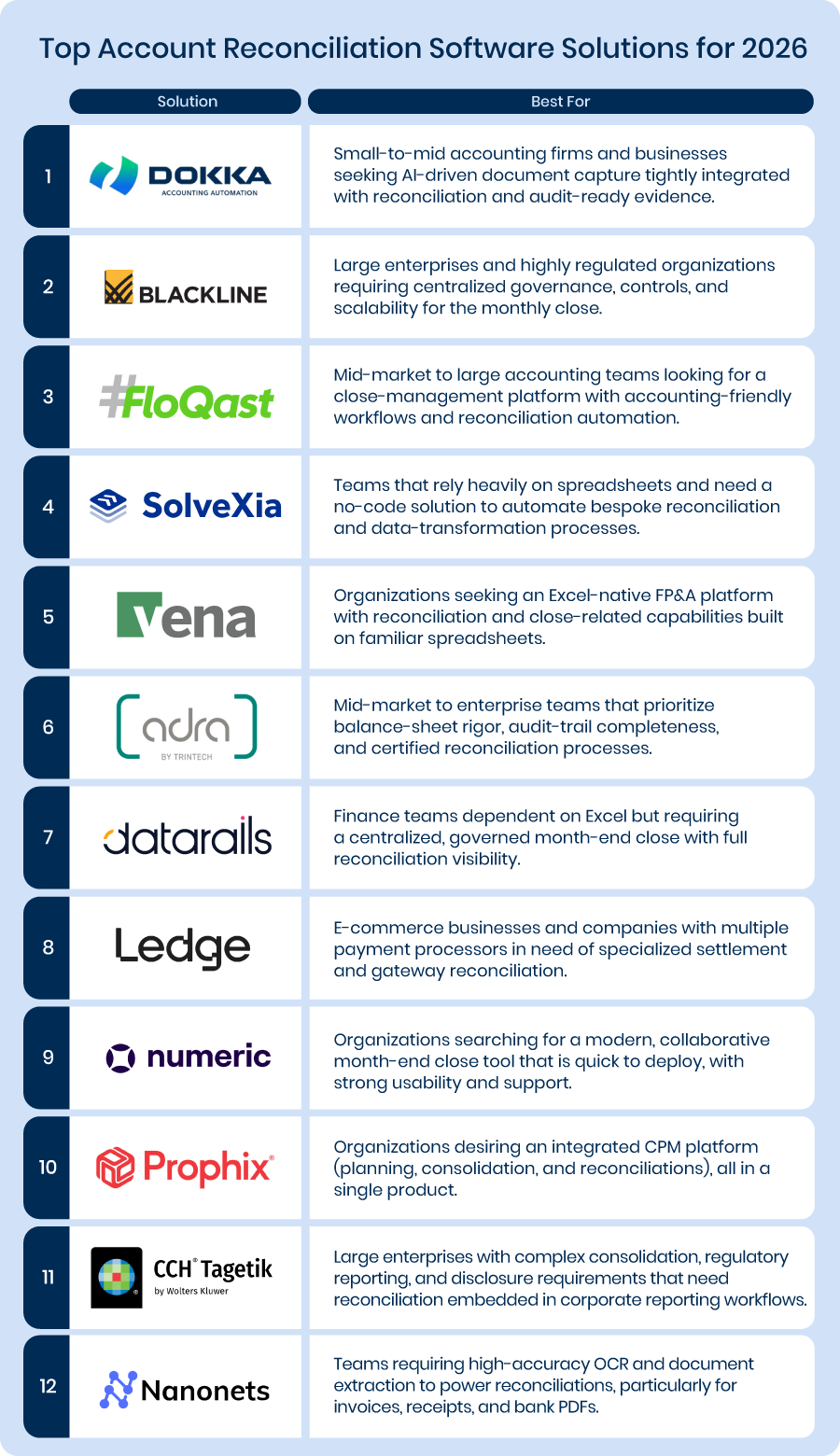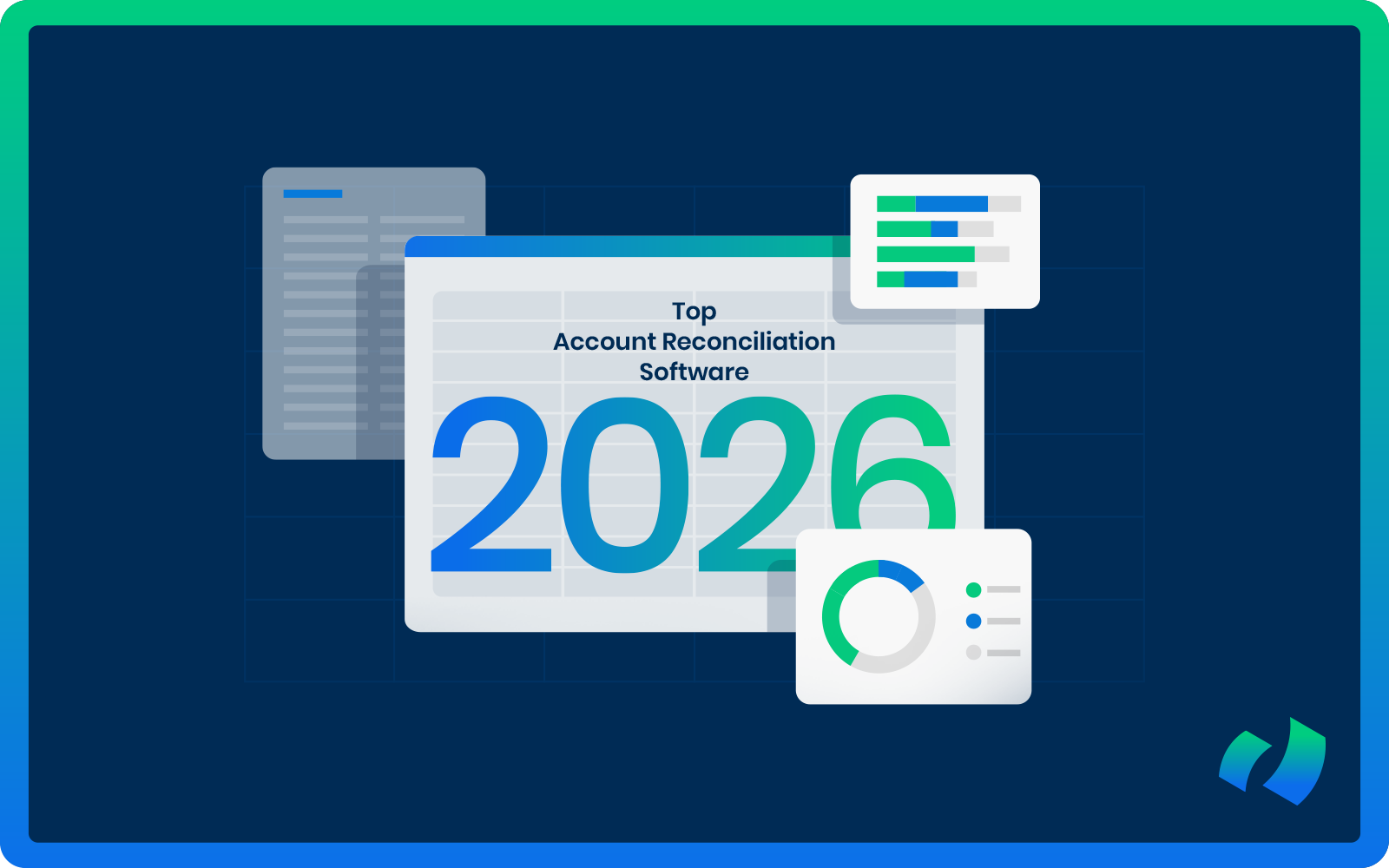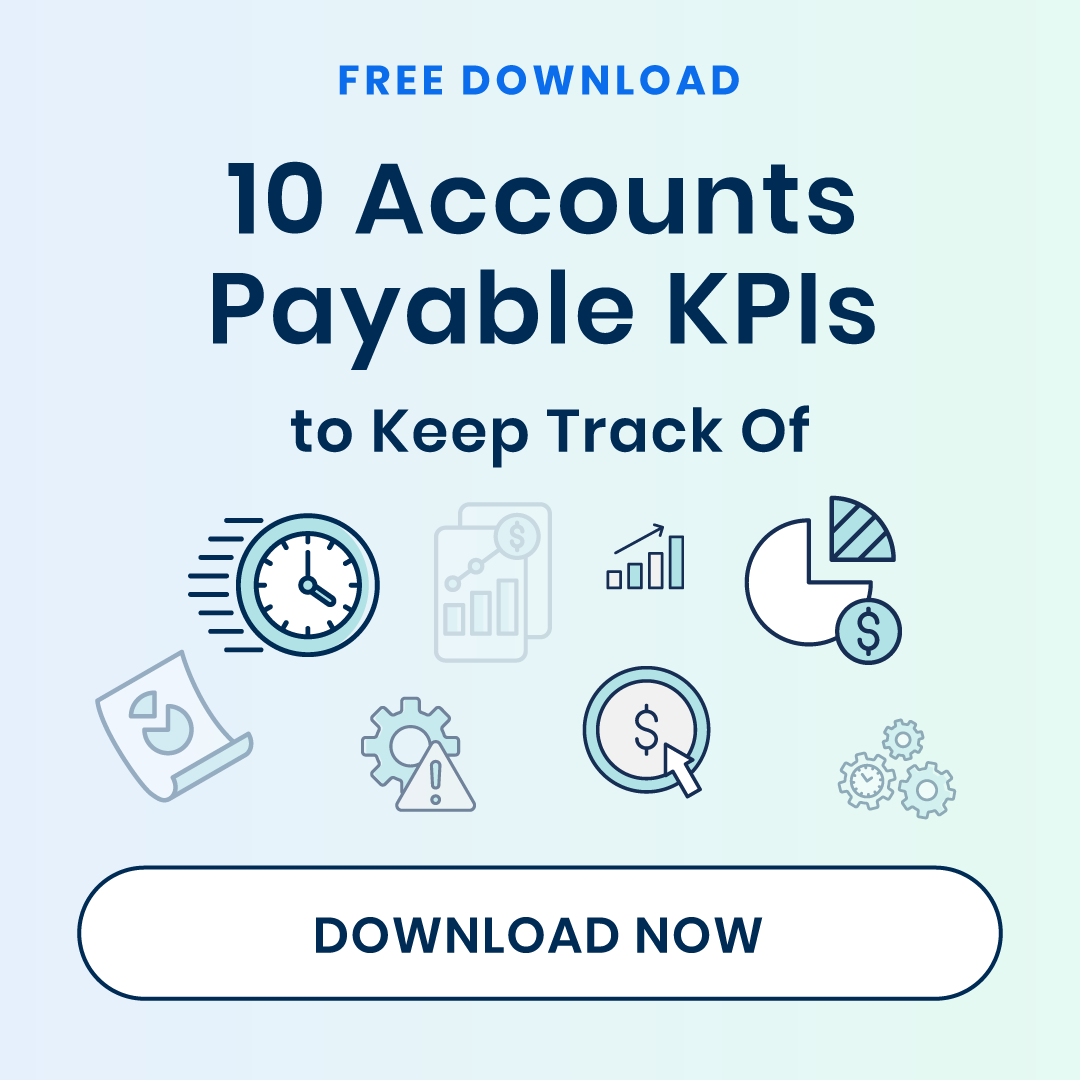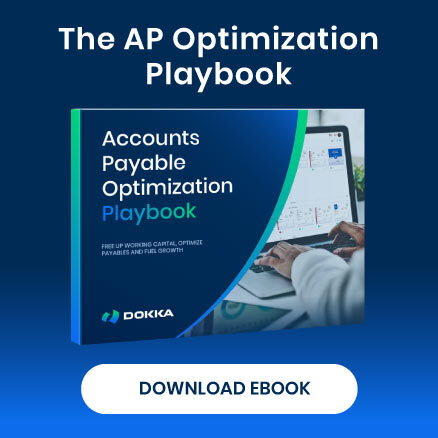Account reconciliation is one of the most time-consuming financial processes within modern finance teams.
Month-end close timelines are accelerating, real-time reporting expectations are skyrocketing, and organizations face increasing pressure to maintain compliance while scaling operations. In this environment, manual spreadsheets, fragmented data, and traditional workflows simply cannot keep up.
For this reason, account reconciliation software has become a core component of the modern finance tech stack.
With dozens of tools offering different workflows, automation levels, and reporting capabilities, the question remains: which one is truly the best for 2026?
To guide your decision, we’ll begin with the fundamentals.
Challenges With Manual Account Reconciliation
Before exploring solutions, it is important to understand why the reconciliation process has become such a bottleneck. For many teams, month-end close is defined by a series of predictable, yet painful obstacles.
Challenge 1: Heavy Spreadsheet Dependence
Despite advances in finance technology, many teams continue to rely on multiple Excel and Google Sheets files. Maintaining formulas, checking links, tracking versions, and reconciling data manually often leads to errors and inefficiency. Spreadsheets are not designed for secure collaboration or controlled financial workflows, which further increases risk.
Challenge 2: Limited Real-Time Visibility
Manual reconciliation restricts visibility across accounts, entities, and periods. Controllers frequently struggle to answer basic questions such as:
- Which accounts are still open?
- What adjustments are missing?
- Where did this discrepancy originate?
Instead, teams spend hours searching through email threads, folder structures, and offline files.
Challenge 3: High Likelihood of Human Error
Typing mistakes, incorrect formulas, copy/paste errors, and inconsistent data formats are common sources of accounting inaccuracies. A single error can cascade across multiple reconciliations, especially during high-pressure close periods.
Challenge 4: Slow and Stressful Month-End Close
Finance professionals can spend up to 50% of close time gathering data, assigning tasks, cross-checking numbers, and manually verifying account balances. Without automation, scalability becomes nearly impossible as transaction volumes increase.
Challenge 5: Compliance and Audit Exposure
Manual processes introduce audit risks due to inadequate documentation control, missing approval tracking, and inconsistent workflows. Teams often cannot easily produce a complete audit trail, leaving the organization vulnerable to compliance challenges.
Challenge 6: Difficult Cross-Functional Collaboration
Accounting, FP&A, auditors, and other departments frequently require access to reconciliation data. Without a centralized system, collaboration becomes fragmented and chaotic.
Given these challenges, an increasing number of organizations are adopting modern reconciliation platforms that automate data capture, centralize documentation, reduce manual workloads, and accelerate the close process.
What Is Account Reconciliation Software?
Account reconciliation software is a digital platform that automates, streamlines, and centralizes the process of validating account balances at month-end. These solutions enhance accuracy, reduce manual effort, and help finance teams maintain compliance through standardized workflows.
Key capabilities typically include:
- Automated data extraction from ERPs, banks, and financial systems
- Matching and variance analysis powered by rules or AI
- Task and workflow automation to manage approvals and close tasks
- Centralized documentation and audit trails
- Real-time dashboards and reporting
- Integration with all major finance systems
The purpose is straightforward: reduce manual work, enable faster and more reliable month-end closes, and provide finance leaders with clarity and control over their financial data.
Now, let’s compare the best account reconciliation software platforms for 2026.
The 12 Best Account Reconciliation Software Solutions to Use in 2026
- DOKKA
- Blackline
- Floqast
- Solvexia
- Vena
- Adra by Trintech
- Datarails
- Ledge
- Numeric
- Prophix
- CCH Tagetik
- Nanonets

1) DOKKA
Best for: Small-to-mid accounting firms and businesses seeking AI-driven document capture tightly integrated with reconciliation and audit-ready evidence.
Overview:
DOKKA’s core promise is taking the pain out of document-heavy reconciliations. Instead of treating PDFs, emailed bank statements, invoices, and receipts as second-class attachments, DOKKA makes them first-class inputs.
The platform ingests unstructured documents, extracts transactions and line items, and carries that structured data directly into reconciliation workflows. This reduces handoffs between capture, matching, and audit documentation while lowering the likelihood of transcription errors that typically create exceptions.
For teams that still receive a lot of paper or PDF feeds, DOKKA shortens the path from source document to certified reconciliation.
Key Features:
- Document ingestion & intelligent OCR: Automatically reads bank statements, invoices, and receipts and converts them into line-level transactions.
- Bank-to-GL matching: Uses the extracted lines to perform automated matching against the general ledger and highlights exceptions.
- Reconciliation workspaces: Provides a place to review, explain, and certify reconciliations alongside the original supporting documents.
- Audit-ready exports & evidence bundles: Packages reconciliation steps and source files in a way auditors can review without digging through inboxes and folders.
Differentiation:
What separates DOKKA from many reconciliation-first tools is its integrated document intelligence. While many reconciliation platforms expect a clean CSV or API feed, DOKKA starts at the messy beginning — PDFs and emails — and follows each document all the way to the reconciled balance. That end-to-end chain of custody (document → extracted data → match → evidence) shortens audits and reduces the manual collation work finance teams face each month.
Pros:
- Extremely easy to use, even for non-technical users
- Best-in-class AI automation for document and data processing
- Centralized reconciliation workspace reduces system switching
- Exceptional support team and fast onboarding
- Deep ERP integrations make it scalable across teams and entities
Cons:
- Still expanding analytics customizations compared to enterprise-focused tools
- Some advanced configuration options require initial implementation support
G2 reviews:
On review sites, users tend to highlight time saved during paper-heavy months, improved audit trails, and easier onboarding for junior staff because the document capture reduces guesswork. Critiques mostly point to edge cases where custom extraction rules are required, which is common for any OCR-oriented product.
2) BlackLine
Best for: Large enterprises and highly regulated organizations requiring centralized governance, controls, and scalability for the monthly close.
Overview:
BlackLine is widely regarded as an enterprise standard for financial close automation. The platform is built to support multi-entity, multi-currency organizations with robust controls, segregation of duties, and an emphasis on auditability.
BlackLine is most often adopted by organizations that need a single source of truth for reconciliations, intercompany eliminations, journal entries, and task orchestration across many accounting teams and departments. The system is designed to replace sprawling spreadsheets and point solutions with a governed, auditable cloud platform.
Key Features:
- Central reconciliation repository: A controlled, searchable place for every reconciliation — certified and versioned.
- Automated matching and exception identification: Automates routine matches and surfaces anomalies for human review.
- Intercompany and consolidated close capabilities: Manages intercompany reconciliation workflows and supports large-scale consolidation processes.
- Controls and audit trail: Detailed logs, certification processes, and role-based access.
Differentiation:
BlackLine’s value lies in its enterprise architecture: scale, compliance, and a mature ecosystem. The platform is built for complex environments where reconciliations must align with internal controls, external audit requirements, and cross-border accounting rules. Integrations with major ERPs and strong governance features make it a frequent choice for finance organizations that prioritize control over speed of initial deployment.
Pros:
- Excellent for standardizing processes across many entities and regions.
- Strong governance reduces audit cycles and compliance headaches.
- Proven at scale in large, multi-division companies.
Cons:
- Implementation can be resource-intensive and requires change management.
- Smaller teams often find the breadth of BlackLine unnecessary and the cost disproportionate.
G2 reviews:
Reviewers consistently praise BlackLine for bringing control and consistency to previously chaotic close processes. Common criticisms reference the learning curve and the need for committed resources during implementation.
3) FloQast
Best for: Mid-market to large accounting teams looking for a close-management platform with accounting-friendly workflows and reconciliation automation.
Overview:
FloQast built its reputation on optimizing the accountant’s day-to-day close experience. The platform wraps reconciliations, task lists, and collaboration tools into a workflow that mirrors how accounting teams already operate, while replacing email threads and spreadsheet checklists with centralized documentation, clearer ownership, and automated matching where appropriate.
Key Features:
- Close checklists and task orchestration: Centralizes responsibilities and deadlines to strengthen accountability.
- AI-assisted matching and reconciliation support: Reduces manual line-by-line work by proposing matches and highlighting likely exceptions.
- Integration with ERPs and reporting tools: Keeps reconciliations tied to underlying ledgers and financial reporting systems.
- Collaboration and review workflows: Allows reviewers to leave notes, request clarifications, and certify reconciliations.
Differentiation:
FloQast places significant emphasis on the human workflow — how accountants organize, review, and certify work. That emphasis makes it a strong choice when culture and minimal disruption matter, as teams gain automation without losing the mental model they associate with spreadsheets.
Pros:
- Fast adoption due to accountant-centric design.
- Reduces repetitive work with AI matching without requiring a major process redesign.
- Strong collaboration features for reviewers and preparers.
Cons:
- For extremely high-volume, fully automated matching across millions of lines, a specialist matching engine or enterprise tool may deliver greater efficiency.
- Some users report occasional sync or performance lags depending on ERP connectivity and data volumes.
G2 reviews:
Users like FloQast’s ease of use and the fast ROI achieved through shorter close cycles. Some reviewers note that additional advanced automation would be useful for extremely high-volume reconciliation environments.
4) Solvexia
Best for: Teams that rely heavily on spreadsheets and need a no-code solution to automate bespoke reconciliation and data-transformation processes.
Overview:
Solvexia offers a no-code automation environment that is especially useful for finance teams who depend on highly customized spreadsheet processes.
Instead of forcing teams to adopt a rigid reconciliation product, Solvexia allows accountants to model their existing processes in a configurable way — pulling data from multiple sources, applying business rules, and creating exception workflows — all without coding. The approach creates a useful bridge for teams that want automation but must preserve unique, non-standard reconciliation logic.
Key Features:
- No-code workflow builder: Create extract-transform-load (ETL) flows and reconciliation logic without programmers.
- Custom matching rules and exception handling: Define the rules your process needs, including complex transforms.
- Scheduling and process automation: Run recurring reconciliation steps and data pulls automatically.
- Analytics and reporting: Track process health and reconciliation metrics.
Differentiation:
Solvexia’s niche is flexibility. Where many reconciliation tools require you to conform to their matching logic, Solvexia asks you to model your logic within a no-code environment. That capability is particularly valuable when reconciliations are idiosyncratic and cannot be solved by out-of-the-box templates.
Pros:
- Extremely flexible automation capabilities
- Good for handling unusual data structures
- Strong processing performance
- Able to scale across varied departments
Cons:
- Interface is more technical than other tools
- Requires time to design and test rules
- Not as user-friendly for smaller teams
G2 reviews:
Users like Solvexia’s power but often mention that you need to invest time in learning the system. Technical finance teams appreciate its customizability.
5) Vena
Best for: Organizations seeking an Excel-native FP&A platform with reconciliation and close-related capabilities built on familiar spreadsheets.
Overview:
Vena’s philosophy is to modernize planning and analysis without forcing Excel power users to abandon their toolset.
The platform centralizes data and controls behind an Excel interface, allowing teams to continue working in spreadsheets while benefiting from a governed data layer, collaboration features, and add-ons that support reconciliation and close processes. Vena reduces version control problems and improves data lineage while maintaining the familiar Excel interface.
Key Features:
- Excel-native interface with centralized data model: Maintains Excel as the UI while eliminating siloed spreadsheets.
- Data integrations: Connects to ERPs and source systems so reconciliations can be performed against a single data source.
- Planning and close orchestration: Combines FP&A workflows with month-end close tasks and reconciliation tracking.
Differentiation:
Vena’s strength lies in minimizing disruption for Excel-dependent teams: users get a centralized, controlled engine under the hood while preserving Excel formulas, layouts, and templates. For organizations where reconciliation logic is tightly tied to Excel models, Vena provides governance without removing spreadsheet flexibility.
Pros:
- Easy for Excel users to adopt
- Combines planning, reporting, and reconciliation
- Flexible workflow management
- Strong training and onboarding materials
Cons:
- Reconciliation module is not as advanced as dedicated platforms
- Requires disciplined Excel use for best results
- Can become complex in larger deployments
G2 reviews:
Users appreciate retained Excel workflows, easier collaboration, and a centralized data source. Some reviews recommend complementing Vena with a dedicated reconciliation product for very high-volume matching needs.
6) Adra by Trintech
Best for: Mid-market to enterprise teams that prioritize balance-sheet rigor, audit-trail completeness, and certified reconciliation processes.
Overview:
Adra is designed to automate balance-sheet reconciliations with a strong emphasis on controls, certification, and visibility. It provides reconciliation templates, roll-forward capabilities for recurring items, and alerts when balances change after certification.
The platform aims to maintain a clean audit trail and to give accounting teams confidence that monthly balances are accurate and fully documented.
Key Features:
- Balance-sheet reconciliation automation: Templates and workflows for standard balance-sheet accounts.
- Certification and roll-forward: Supports certified reconciliations and carries forward long-lived reconciling items with clear visibility.
- Audit trail and change alerts: Notifies users if certified items are modified and stores evidence for auditors.
Differentiation:
Adra’s focus centers on process integrity. Whereas some tools optimize speed or user experience, Adra emphasizes accountability and traceability — essential for organizations that must demonstrate rigorous controls and clear, verifiable evidence of review.
Pros:
- Clear workflows and easy-to-follow processes
- Well-suited for compliance-driven teams
- Scalable without added complexity
- Solid matching engine
Cons:
- Limited customization options
- Interface can feel dated
- Implementation sometimes slower than expected
G2 reviews:
Users appreciate Adra’s reliability and structured design, although many say the interface could be more intuitive. Numerous reviewers note that the matching engine is strong but configuration flexibility is limited.
7) Datarails
Best for: Finance teams dependent on Excel but requiring a centralized, governed month-end close with full reconciliation visibility.
Overview:
Datarails centralizes Excel-based reporting and reconciliations by connecting spreadsheets to a governed data warehouse. It helps teams eliminate version control issues while maintaining the familiar spreadsheet experience.
Datarails also provides close-tracking features, allowing teams to see where reconciliations and other month-end tasks stand in real time.
Key Features:
- Excel-first reporting with centralized data: Securely connect spreadsheets to a single source of truth.
- Month-end close trackers: Dashboards and task management for reconciliations and close activities.
- Templates and integration tools: Map common reconciliation templates into a centralized platform.
Differentiation:
Datarails acts as a bridge rather than a replacement. If a team’s expertise and processes are entrenched in spreadsheets, Datarails preserves that front-end while removing the fragility associated with email-driven spreadsheets and local file copies.
Pros:
- Familiar Excel-like modeling
- Excellent for FP&A teams
- Reduces manual consolidation work
- Provides solid analytics features
Cons:
- Not primarily built for reconciliation
- Setup can be time-consuming
- Matching rules are not as automated as other tools
G2 reviews:
Customers frequently praise the relief from spreadsheet versioning issues and the visibility provided during month-end close. Some reviews note that integration can be challenging depending on ERP complexity.
8) Ledge
Best for: E-commerce businesses and companies with multiple payment processors in need of specialized settlement and gateway reconciliation.
Overview:
Ledge was developed to address a common challenge in modern commerce: the mismatch between orders, payment processor settlements, and how those flows are recorded in the GL.
It focuses on reconciling payments across gateways, marketplaces, and processors, handling multi-leg settlements, fees, refunds, and split settlements so teams don’t have to manually trace every platform remittance back to the ledger.
Key Features:
- Multi-gateway reconciliation: Collects and normalizes feeds from gateways and marketplaces.
- Rules-based matching for settlements and fees: Automates fee allocation, multi-leg settlements, and adjustments.
- Real-time or near real-time reporting: Helps treasury and operations teams quickly identify shortfalls and timing mismatches.
Differentiation:
General reconciliation tools attempt to serve all accounts, while Ledge specializes in commerce payment complexity. It understands the unique patterns of processor settlements, merchant fees, and marketplace remittances—areas that general-purpose reconciliation tools often don’t handle as elegantly.
Pros:
- Modern architecture with strong APIs
- Well-suited for high-volume transaction environments
- Real-time visibility
- Developer-friendly
Cons:
- Less suited for traditional accounting teams
- Requires technical configuration
- Limited broader financial close features
G2 reviews:
Users highlight Ledge for drastically reducing manual allocations and resolving a major time-sink for payments teams. Its specialized nature means it is often used alongside broader ERP or finance platforms.
9) Numeric
Best for: Organizations searching for a modern, collaborative month-end close tool that is quick to deploy, with strong usability and support.
Overview:
Numeric emphasizes a modern web UI, collaborative close workspaces, and quick onboarding. The product is designed to help teams complete the month-end close faster by providing visibility into reconciliation status, journal entries, and accountability for each deliverable.
As a newer entrant compared with some legacy vendors, Numeric positions itself around rapid deployment and excellent customer support.
Key Features:
- Central month-end workspace: Tracks reconciliations, tasks, and journal entries in a single location.
- Collaboration tools and comments: Designed for modern accounting teams that rely on asynchronous collaboration.
- Fast onboarding and support: Focused on reducing time-to-value.
Differentiation:
Numeric stands out for its user experience and speed of implementation. Teams looking for a straightforward close tool without heavy technical demands will find that Numeric reduces friction and quickly boosts productivity.
Pros:
- Easy to adopt
- Strong variance insights
- Clean, modern UX
- Good collaboration features
Cons:
- Less robust matching automation
- Not ideal for high-volume reconciliations
- Limited custom workflow options
G2 reviews:
Users frequently highlight Numeric’s clean interface and helpful analytics. Some note that it functions more as a close management tool than as a full reconciliation automation engine.
10) Prophix
Best for: Organizations desiring an integrated CPM platform (planning, consolidation, and reconciliations), all in a single product.
Overview:
Prophix is a corporate performance management vendor with capabilities that span planning, consolidation, and reconciliation. The platform is most effective where the close, forecast, and consolidation processes need to be tightly linked.
Embedding reconciliation into the CPM avoids disconnected systems for planning and close, helping to surface reconciliation-driven adjustments in planning scenarios.
Key Features:
- Integrated reconciliation with consolidation: Reconciliations feed directly into consolidated reporting and disclosures.
- Automation across FP&A and close: Reduces duplicate data entry and improves the accuracy of scenario analysis.
- Dashboards and reporting: Visualize reconciliation health across entities and time periods.
Differentiation:
Prophix’s key differentiator is breadth. The platform emphasizes ensuring reconciliations are part of the broader financial planning and consolidation story rather than being the fastest matching engine.
Pros:
- Comprehensive FP&A suite
- Reliable workflow tooling
- Strong option for growing companies
- Good visualization capabilities
Cons:
- Reconciliation features are not highly automated
- Learning curve can be steep
- User interface may feel outdated to some users
G2 reviews:
Users appreciate Prophix’s integrated approach but note that reconciliation is not a core focus. Several users describe the interface as functional but not modern.
11) CCH Tagetik
Best for: Large enterprises with complex consolidation, regulatory reporting, and disclosure requirements that need reconciliation embedded in corporate reporting workflows.
Overview:
CCH Tagetik (Wolters Kluwer) integrates reconciliation and matching into a broader disclosure and reporting platform. It is often selected by regulated companies that require end-to-end capabilities: reconciliations that tie directly into consolidations, regulatory reports, and disclosures.
Tagetik’s platform is designed to support complex accounting rules, localized reporting requirements, and enterprise-grade data models.
Key Features:
- Transaction matching and reconciliation templates: Built-in patterns for a wide range of reconciliation scenarios.
- Integration with consolidation and disclosure: Strong linkage between reconciled balances and reporting deliverables.
- Compliance and regulatory support: Tools that assist teams in meeting external reporting obligations.
Differentiation:
Tagetik specializes in organizations where reconciliations form part of a larger regulatory and reporting framework. The platform goes beyond simple matching; it ensures reconciled balances feed into the numbers auditors and regulators expect across consolidated reports.
Pros:
- Extremely robust for enterprise environments
- Strong compliance and reporting capabilities
- Supports complex global structures
- Highly configurable
Cons:
- Long implementation timeline
- Expensive for smaller organizations
- Steeper learning curve due to extensive feature set
G2 reviews:
Users praise Tagetik’s power and flexibility but note that mastering it requires time. Enterprise teams particularly value its consolidation tools.
12) Nanonets
Best for: Teams requiring high-accuracy OCR and document extraction to power reconciliations, particularly for invoices, receipts, and bank PDFs.
Overview:
Nanonets specializes in AI-driven OCR and document understanding. The platform trains models to extract structured data from diverse document types and delivers high-fidelity results to downstream systems.
In reconciliation workflows, Nanonets is frequently used as the front-end capture layer: feed PDFs into Nanonets, receive structured transactions in return, and push those into a reconciliation engine or GL.
Key Features:
- AI model training and custom extraction pipelines: Train models on specific document layouts to enhance accuracy.
- APIs and connectors: Deliver structured extracts to reconciliation engines, ERPs, or data warehouses.
- Scalability for high-volume ingestion: Built to process large batches of documents efficiently.
Differentiation:
Nanonets focuses on teams whose reconciliations are slowed by poor document capture. If low-quality PDFs and images are limiting the data feeding your reconciliation engine, Nanonets addresses that bottleneck without requiring changes to your reconciliation system.
Pros:
- Excellent OCR accuracy
- Fast document capture
- Versatile API
- Useful for automating repetitive data entry
Cons:
- Not a complete reconciliation solution
- Limited financial close features
- Requires integration with other systems
G2 reviews:
Customers highlight the OCR accuracy and speed at which custom models can be trained. Suggestions often include adding better out-of-the-box templates for niche document types, but overall sentiment is positive for extraction-heavy use cases.
Why DOKKA Is the Best Account Reconciliation Software For 2026
When you map the reconciliation journey end-to-end, three common bottlenecks emerge:
- Capture: getting the right data out of PDFs, emails, and other unstructured sources.
- Matching: efficiently matching those transactions to ledger lines and handling exceptions at scale.
- Audit & Evidence: packaging certifiable evidence for auditors and maintaining a clean trail.
Many vendors excel in one of these areas — Datarails, Vena, and Prophix support Excel-first teams; BlackLine, CCH Tagetik, and Adra emphasize governance and consolidation; Ledge focuses on payments; Nanonets and DOKKA address the capture problem.
DOKKA’s advantage lies in combining capture and reconciliation within the same platform: the system not only extracts data but also uses it as the primary input for reconciliations, linking the original documents directly to reconciliation records. This reduces context loss, speeds up exception resolution, and makes audits significantly easier.
For reconciliation challenges that begin with messy documents and extensive manual evidence-gathering, DOKKA provides:
- Document ingestion and OCR for bank statements, invoices, and receipts.
- Automated bank-to-GL matching using extracted line items as the match universe.
- Balance-sheet reconciliation guidance and certification workflows.
- Packaged, audit-ready evidence linking each reconciled item back to the original document.
The end-to-end approach is why, for many small and mid-sized accounting teams and firms in 2026, DOKKA represents the most practical, time-saving reconciliation solution.
Want to learn how DOKKA can help your team improve reconciliations? Book a demo to see it in action.
Disclaimer:
All information presented about third-party products, pricing, or features is based on publicly available sources at the time of writing and is intended for general informational purposes only. DOKKA makes no representations or warranties regarding the accuracy, completeness, or correctness of competitor data. All trademarks and brand names are the property of their respective owners.
We encourage readers to verify details with the respective vendors before making any purchasing decisions.




